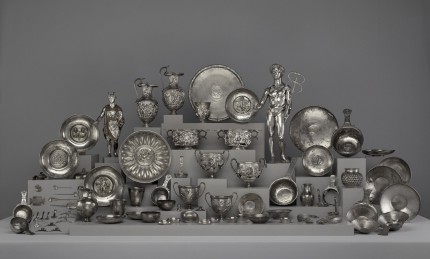
For the first time since it was discovered in 1830, the entire
 Berthouville Treasure, a group of exceptional Roman silver objects, has left France and is on display at the Getty Villa in Malibu. Ancient Luxury and the Roman Silver Treasure from Berthouville exhibits the complete 93-piece treasure — which includes a statue of Mercury, elaborately decorated silver pitchers and cups, a repoussé silver jug, plain silver beakers, a spoon collection and a number broken handles, rims and fittings — along with a selection of luxurious jewels, like the eight gold, emerald, pearl and amethyst necklaces of the Treasure of Naix, all on loan from the Département des Monnaies, Médailles et Antiques (the department of coins, medals and antiques) of the Bibliothèque Nationale de France.
Berthouville Treasure, a group of exceptional Roman silver objects, has left France and is on display at the Getty Villa in Malibu. Ancient Luxury and the Roman Silver Treasure from Berthouville exhibits the complete 93-piece treasure — which includes a statue of Mercury, elaborately decorated silver pitchers and cups, a repoussé silver jug, plain silver beakers, a spoon collection and a number broken handles, rims and fittings — along with a selection of luxurious jewels, like the eight gold, emerald, pearl and amethyst necklaces of the Treasure of Naix, all on loan from the Département des Monnaies, Médailles et Antiques (the department of coins, medals and antiques) of the Bibliothèque Nationale de France.
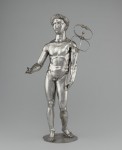 On March 21st, 1830, farmer Prosper Taurin was working his field in Berthouville, near Bernay, Normandy, when his plowshare jammed against an ancient Roman tile. Once dislodged, the tile was found to be protecting a trove of 95 or so Roman silver and gold objects buried only eight inches beneath the soil. Weighing a total of 55 pounds, the stand-out pieces were two statuettes of the god Mercury and about 60 vessels.
On March 21st, 1830, farmer Prosper Taurin was working his field in Berthouville, near Bernay, Normandy, when his plowshare jammed against an ancient Roman tile. Once dislodged, the tile was found to be protecting a trove of 95 or so Roman silver and gold objects buried only eight inches beneath the soil. Weighing a total of 55 pounds, the stand-out pieces were two statuettes of the god Mercury and about 60 vessels.
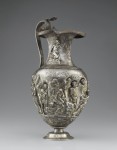 Several of the vessels were incscribed with votive dedications to Mercury, including a group of nine ultra deluxe gilded silver vessels — a pair of wine pitchers with scenes from the Trojan War, a pair of drinking cups decorated with scenes of centaurs, a pair of drinking cups with masks, a silver and gold beaker with scenes from the story of Corinth and Isthmia, a large bowl with a central medallion of Omphale and Eros laying on Hercules’ Nemean lion skin and a ladle decorated with Mercury, a goat and a tree — made in the 1st century. These nine pieces all bear the inscription “MERCVRIO AVGVSTO Q DOMITIVS TVTVS EX VOTO,” or “To August Mercury from Quintus Domitius Tutus as vowed,” and are superlatively high quality silver and gold work from 1st century Italy.
Several of the vessels were incscribed with votive dedications to Mercury, including a group of nine ultra deluxe gilded silver vessels — a pair of wine pitchers with scenes from the Trojan War, a pair of drinking cups decorated with scenes of centaurs, a pair of drinking cups with masks, a silver and gold beaker with scenes from the story of Corinth and Isthmia, a large bowl with a central medallion of Omphale and Eros laying on Hercules’ Nemean lion skin and a ladle decorated with Mercury, a goat and a tree — made in the 1st century. These nine pieces all bear the inscription “MERCVRIO AVGVSTO Q DOMITIVS TVTVS EX VOTO,” or “To August Mercury from Quintus Domitius Tutus as vowed,” and are superlatively high quality silver and gold work from 1st century Italy.
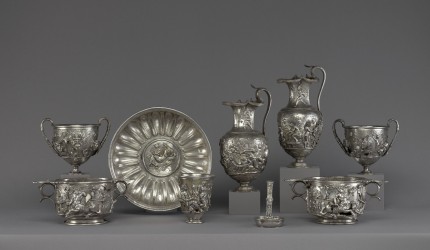
Subsequent archaeological excavations of the site in 1861 and 1896 found two temples, a theater and hypocaust-heated rooms: a Gallo-Roman sanctuary built in at least two stages. One of the temples was dedicated to the important Romanized Gallic deity Mercury Canetonensis, the same god name-checked in the vessels’ votive inscriptions. The other was dedicated either to his mother Maia or his wife Rosmerta. The hoard was buried under the brick paving in the gallery of the sanctuary.
 Archaeologists did not encounter evidence of a town or cemetery in the vicinity of the sanctuary, so it seems likely to have been a pilgrimage site. The objects date from the 1st to the late 2nd centuries A.D. and are therefore thought to have been buried in the late 2nd, early 3rd century. They could have been buried for their own preservation during turbulent times, but given the context they may have been cached for ritual purposes rather than under extremis.
Archaeologists did not encounter evidence of a town or cemetery in the vicinity of the sanctuary, so it seems likely to have been a pilgrimage site. The objects date from the 1st to the late 2nd centuries A.D. and are therefore thought to have been buried in the late 2nd, early 3rd century. They could have been buried for their own preservation during turbulent times, but given the context they may have been cached for ritual purposes rather than under extremis.
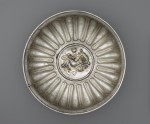 Taurin put the treasure in the hands of a local nobleman who prevented archaeologists from examining it. An expert from the Louvre and one from the Cabinet des Médailles of the Bibliothèque Royale, today the Département des Monnaies, Médailles et Antiques of the Bibliothèque Nationale de France, were allowed access to the group to arrange a sale. The Cabinet acquired the treasure for 15,000 francs, a modest sum even then. At the library in Paris the objects were cleaned and the fragments that could be puzzled back together were. There the Berthouville Treasure remained (with some individual pieces taking occasional short trips elsewhere in France) for 180 years.
Taurin put the treasure in the hands of a local nobleman who prevented archaeologists from examining it. An expert from the Louvre and one from the Cabinet des Médailles of the Bibliothèque Royale, today the Département des Monnaies, Médailles et Antiques of the Bibliothèque Nationale de France, were allowed access to the group to arrange a sale. The Cabinet acquired the treasure for 15,000 francs, a modest sum even then. At the library in Paris the objects were cleaned and the fragments that could be puzzled back together were. There the Berthouville Treasure remained (with some individual pieces taking occasional short trips elsewhere in France) for 180 years.
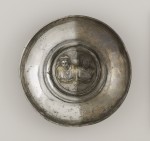 In December of 2010, the whole treasure was shipped to the Getty Villa for an extensive program of documentation, analysis, research, cleaning and conservation. Each of the 93 objects (plus four unrelated platters from late antiquity in the Cabinet collection) were photographed and X-rayed to assess their condition and for evidence of how they were manufactured. After a metallurgic study, conservators began to clean the surface of the vessels with simple damp cotton swabs. The grime and dust removal promptly revealed gilding and inscription details that had long been obscured. Further progress was made with mild cleansers and solvents like acetone and ethanol which were able to remove the thick tarnish layers, accretions and corrosion that the 19th century conservation had been unable to budge.
In December of 2010, the whole treasure was shipped to the Getty Villa for an extensive program of documentation, analysis, research, cleaning and conservation. Each of the 93 objects (plus four unrelated platters from late antiquity in the Cabinet collection) were photographed and X-rayed to assess their condition and for evidence of how they were manufactured. After a metallurgic study, conservators began to clean the surface of the vessels with simple damp cotton swabs. The grime and dust removal promptly revealed gilding and inscription details that had long been obscured. Further progress was made with mild cleansers and solvents like acetone and ethanol which were able to remove the thick tarnish layers, accretions and corrosion that the 19th century conservation had been unable to budge.
The restoration project took four years to complete and the beautiful results are now on display in California. The exhibition runs at the Getty Villa through August 17th, 2015, after which it returns to Paris whose citoyens will get a chance to see the treasure clean and shiny for the first time.
Here’s a nifty video from the Getty conservation team on how Roman silversmiths would have made the Cup of the Centaurs.
[youtube=http://youtu.be/lrMVA8F-fiY&w=430]